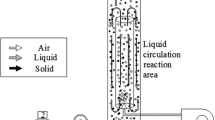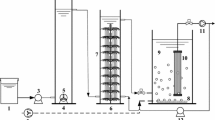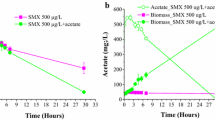Abstract
A highly effective naphthalene-degrading bacterial strain was isolated from acclimated activated sludge from a coal gasification wastewater plant, and identified as a Streptomyces sp., designated as strain QWE-35. The optimal pH and temperature for naphthalene degradation were 7.0 and 35°C. The presence of additional glucose and methanol significantly increased the degradation efficiency of naphthalene. The strain showed tolerance to the toxicity of naphthalene at a concentration as great as 200 mg/L. The Andrews mode could be fitted to the degradation kinetics data well over a wide range of initial naphthalene concentrations (10–200 mg/L), with kinetic values q max = 0.84 h−1, K s = 40.39 mg/L, and K i = 193.76 mg/L. Metabolic intermediates were identified by gas chromatography and mass spectrometry, allowing a new degradation pathway for naphthalene to be proposed for the first time. Strain QWE-35 was added into a membrane bioreactor (MBR) to enhance the treatment of real coal gasification wastewater. The results showed that the removal of chemical oxygen demand and total nitrogen were similar between bioaugmented and non-bioaugmented MBRs, however, significant removal of naphthalene was obtained in the bioaugmented reactor. The findings suggest a potential bioremediation role of Streptomyces sp. QWE-35 in the removal of naphthalene from wastewaters.




Similar content being viewed by others
References
Andersen RG, Booth EC, Marr LC, Widdowson MA, Novak JT (2008) Volatilization and biodegradation of naphthalene in the vadose zone impacted by phytoremediation. Environ Sci Technol 42:2575–2581
Chang HY, Hung JM, Wu YS, Lin YR, Lai HY, Lu CJ (2009) Effect of applying biosolids on the biodegradation of toluene and naphthalene contaminated soils. J Environ Biol 30:971–975
Farjadfard S, Borghei SM, Hassani AH, Yakhchali B, Ardjmand M, Zeinali M (2012) Efficient biodegradation of naphthalene by a newly characterized indigenous Achromobacter sp FBHYA2 isolated from Tehran Oil Refinery Complex. Water Sci Technol 66:594–602
Filonov AE, Puntus IF, Karpov AV, Kosheleva IA, Akhmetov LI, Yonge DR, Petersen JN, Boronin AM (2006) Assessment of naphthalene biodegradation efficiency of Pseudomonas and Burkholderia strains tested in soil model systems. J Chem Technol Biotechnol 81:216–224
Filonov AE, Akhmetov LI, Puntus IF, Esikova TZ, Gafarov AB, Kosheleva IA, Boronin AM (2010) Horizontal transfer of catabolic plasmids and naphthalene biodegradation in open soil. Microbiology 79:184–190
Gu L, Zhu N, Wang L, Bing X, Chen X (2011) Combined humic acid adsorption and enhanced Fenton processes for the treatment of naphthalene dye intermediate wastewater. J Hazard Mater 198:232–240
Gu L, Zhu N, Guo H, Huang S, Lou Z, Yuan H (2013) Adsorption and Fenton-like degradation of naphthalene dye intermediate on sewage sludge derived porous carbon. J Hazard Mater 246:145–153
Horng RS, Kuei C, Chen W (2009) Enhancement of aromatic hydrocarbon biodegradation by toluene and naphthalene degrading bacteria obtained from lake sediment: the effects of cosubstrates and cocultures. J Environ Eng 135:854–860
Jajuee B, Margaritis A, Karamanev D, Bergougnou MA (2007) Kinetics of biodegradation of p-xylene and naphthalene and oxygen transfer in a novel airlift immobilized bioreactor. Biotechnol Bioeng 96:232–243
Kang H, Hwang SY, Kim YM, Kim E, Kim YS, Kim SK, Kim SW, Cerniglia CE, Shuttleworth KL, Zylstra GJ (2003) Degradation of phenanthrene and naphthalene by a Burkholderia species strain. Can J Microbiol 49:139–144
Lee K, Park JW, Ahn IS (2003) Effect of additional carbon source on naphthalene biodegradation by Pseudomonas putida G7. J Hazard Mater 105:157–167
Lin C, Gan L, Chen Z (2010) Biodegradation of naphthalene by strain Bacillus fusiformis (BFN). J Hazard Mater 182:771–777
Maillacheruvu KY, Pathan IA (2009) Biodegradation of naphthalene, phenanthrene, and pyrene under anaerobic conditions. J Environ Sci Health A 44:1315–1326
Mollea C, Bosco F, Ruggeri B (2005) Fungal biodegradation of naphthalene: microcosms studies. Chemosphere 60:636–643
O’Loughlin EJ, Kehrmeyer SR, Sims GK (1996) Isolation, characterization, and substrate utilization of a quinoline-degrading bacterium. Int Biodeter Biodegr 38:107–118
Seo J, Keum Y, Hu Y, Lee S, Li QX (2007) Degradation of phenanthrene by Burkholderia sp C3: initial 1,2- and 3,4-dioxygenation and meta- and ortho-cleavage of naphthalene-1,2-diol. Biodegradation 18:123–131
Shah PD, Dave SR, Rao MS (2012) Enzymatic degradation of textile dye Reactive Orange 13 by newly isolated bacterial strain Alcaligenes faecalis PMS-1. Int Biodeter Biodegr 69:41–50
Zhao W, Huang X, Lee D, Wang X, Shen Y (2009) Use of submerged anaerobic-anoxic-oxic membrane bioreactor to treat highly toxic coke wastewater with complete sludge retention. J Membr Sci 330:57–64
Zheng C, Qu B, Wang J, Zhou J, Wang J, Lu H (2009) Isolation and characterization of a novel nitrobenzene-degrading bacterium with high salinity tolerance: Micrococcus luteus. J Hazard Mater 165:1152–1158
Acknowledgments
This work was supported by Harbin Institute of Technology (2013DX10) and the Sino-Dutch Research Program (zhmhgfs2011-001).
Author information
Authors and Affiliations
Corresponding author
Rights and permissions
About this article
Cite this article
Xu, P., Ma, W., Han, H. et al. Isolation of a Naphthalene-Degrading Strain from Activated Sludge and Bioaugmentation with it in a MBR Treating Coal Gasification Wastewater. Bull Environ Contam Toxicol 94, 358–364 (2015). https://doi.org/10.1007/s00128-014-1366-7
Received:
Accepted:
Published:
Issue Date:
DOI: https://doi.org/10.1007/s00128-014-1366-7




